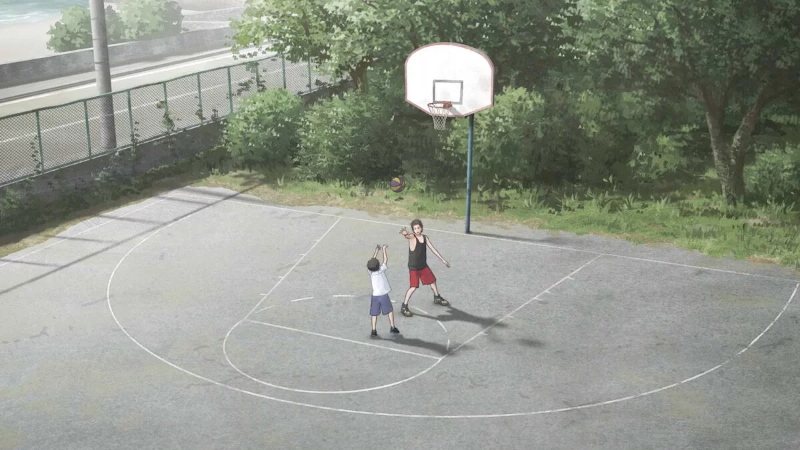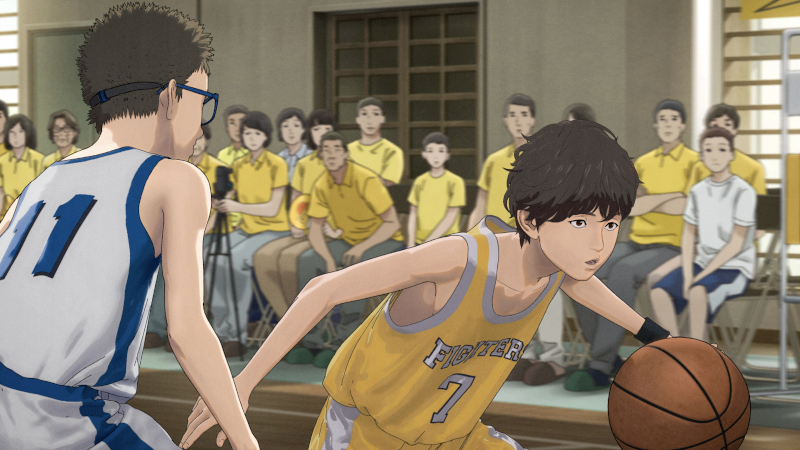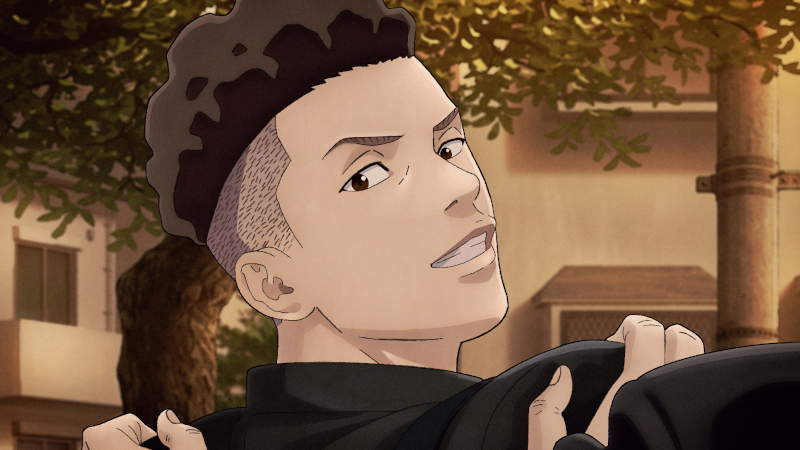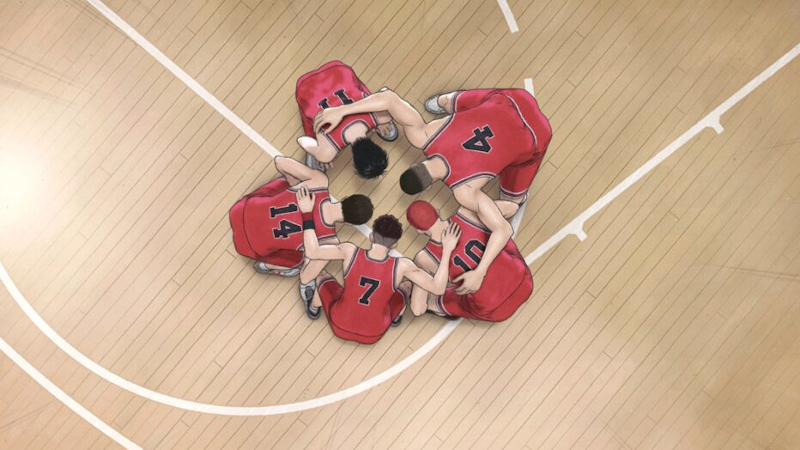Director – Takehiko Inoue – 2022 – Japan – Cert. 12a tbc – 124m
*****
A high school basketball team sets out to defeat the seemingly unstoppable league champions – on 4K UHD + Blu-ray Collector’s Edition, Steelbook, Blu-ray, and DVD on 24th March
The coastal town of Shohoku. 11-year-old Ryota Miyagi (voice: Miyuri Shimabukuro) lives in the shadow of his 14-year-old, elder brother and school basketball star Sota (voice: Gakuto Kajiwara). One evening, Sota takes his younger sibling out for a practice at the local court, playing as hard as he can to push Ryota, which makes the youngster want to push himself harder still. Sota then alienates Ryota by going on a fishing trip with his peer group rather than respond to Ryota’s demand to extend their practice session. When his elder brother is tragically killed at sea, Ryota must both step into both the role of man of the house and prove himself in the school basketball team.

By the time Ryota is 17 (voice: Shugo Nakamura), he is one of the players on the Shohoku school basketball team which itself faces challenges: specifically, if it is to win the national championships, it must defeat the the seemingly unstoppable reigning champions the Sannoh school basketball club and their star player Masashi Kawata (voice: Mitsuaki Kanuka), Ryota’s opposite number (both wear their team’s no. 7 shirt). Shohoku’s own players have different strengths. Ryota creates the play breaks by virtue of his speed, redhead Hanamichi Sakuragi (voice: Subaru Kimura) is a jumper who can repel seemingly certain opposition shots at the hoop, Hisashi Mitsui (voice: Jun Kasama) an accurate shooter, rookie Kaede Rukawa (voice: Shin’ichiro Kamio) determined to become the best player in Japan. Shohoku’s captain Takenori Akagi (voice: Kenta Miyake) eagerly anticipates confrontation with Sannoh.
The narrative alternates between Shohoku / Sannoh games, Shohoku school life and Ryota’s home and family life. There are not only moments of bullying cliques beating up lone boys that wouldn’t be out of place in definitive, Japanese high school epic Blue Spring (Toshiaki Toyoda, 2001) but also scenes of, first, middle-aged coach Mitsuyoshi Anzai (voice: Katsuhisa Hoki) imparting spiritual truths to his team and, second, no-nonsense manager Ayako (voice: Asami Seto), a tough woman in a man’s world, keeping them in order on the court.
In between games and school, Ryota, little sister Anna (voice: Misaki Kuno) and their mum Kaoru (voice: Mie Sonozaki) grapple with the loss of first-born son Sota, whose presence is felt by his absence throughout the film after his brief appearance in the opening reel. The two brothers share the same birthday, Sota having been born three years earlier to the day. Nowhere is this more poignant than the Ryota’s 17th birthday, where mother and three children (including the deceased Sota) each get a plate on the kitchen table with a slice of cake.
Ryota’s coming to terms with his brother’s death and trying to be his own person rather than stepping into the star shoes of his brother in the competitive world of school basketball forms one narrative spine, skilfully intertwined with the other about the Shohoku team’s determination to wrest the championship from Sannoh. This culminates, after a number of matches between the two rival schools, in their facing off at the final where clear underdogs Shohoku have everything to play for against favourites to win Sannoh.

Anime has something of a history for representing competitive team sports in in the medium of the moving image, as shown by the animated clips in the excellent documentary about the international success of the Japanese women’s volleyball team 1962-64 The Witches Of The Orient (Julien Faraut, 2021).
However, if you think you can imagine just how exciting and expressive competitive team sports generally or basketball specifically can be on the screen, or if you think you know what to expect from that subject being tackled in animation, be prepared to think again.
Takashi Inoue, the manga artist who created the Slam Dunk series in Japan’s Weekly Shonen Jump magazine, fought off various short animated pitches from the production company until he felt they were getting close enough to his vision, then wanted to become involved so that he could be sure that things that weren’t quite true to that vision could be worked on until they were on a par with what he imagined. He wrote a screenplay and somehow wound up directing it, which wasn’t his original intention, or so the press handouts would have it.

It’s called The First Slam Dunk because it focuses on a different protagonist from those at the centre of the manga narrative, meaning that this is a story that fans of the franchise won’t have encountered before. Not that any prior knowledge of the property is required: if, like this writer, The First Slam Dunk is your first encounter with the franchise, there’s nothing you need to know that isn’t totally self-contained within this movie.
As far as directing an animated movie goes, Inoue appears to be a natural. He knows how to take you inside the head space of his characters, both on and off the basketball court, and makes you live their challenges alongside them for the two hours you’re in the movie theatre. He clearly understands the game of basketball inside out, and uses animation to take you right inside the game and its various plays and moves in ways that would be near-impossible in live action and are completely groundbreaking in animation. He possesses a very real sense of the way time can either speed up or slow right down in a competitive sport; in this respect, the movie stands as an animated equivalent of Raging Bull (Martin Scorsese, 1980), which achieved much in live action by overcranking the camera to slow everything down during its boxing scenes. While the arsenal of tools available to a filmmaker working in animation are obviously very different to those of live action, the two sports films bear serious comparison.

The use of sound is exemplary too, running the gamut from intense passion of kinetic imagery with cranked up rock music through to moments of serenity and calm where you can hear a pin drop. I was fortunate enough to see a Dolby Atmos print shown in one of Dolby’s own, specially equipped, proprietary theatres – and what an incredible difference that made. The moral: try and see this film in as well equipped and maintained a cinema as you can – it’s a very special work which will benefit considerably.
The First Slam Dunk deserves to be widely seen, utterly transcending as it does either the medium of animation – Japanese or otherwise – or the sports movie genre. In short, the Raging Bull of animation: an utterly extraordinary achievement.
The First Slam Dunk is on 4K UHD + Blu-ray Collector’s Edition, Steelbook, Blu-ray, and DVD on 24th March 2025 following its 2023 debut in the Annecy International Animation Festival from Wednesday, June 14th; Edinburgh Film Festival from Wednesday, August 22nd-23rd; out in cinemas in the UK and Ireland on Wednesday, August 30th.
Teaser Trailer:
Festival Trailer:
